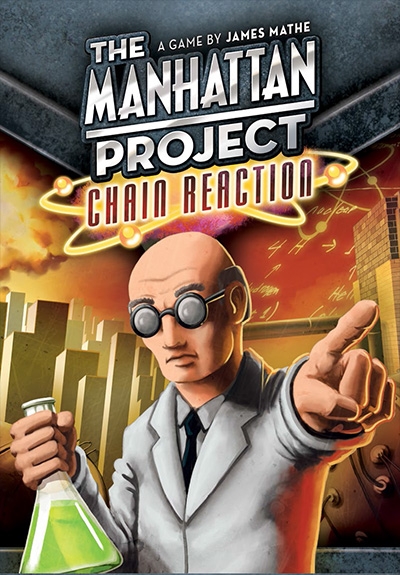Finally, a game about “yellow cake” that doesn’t include a three-second rule. You see, this kind of yellow cake is a tad…well, nuclear. In “The Manhattan Project: Chain Reaction”, you’ll be using yellow cake, uranium, and labor in order to build bombs and score victory points. Doing this will involve the chaining of cards so that inputs produce outputs, although cards can be used for their indicated labor too (not both). We chose to share our first playthrough and first impressions in the video below so that you can see how gameplay flows, but our resolve that the game is awesome still holds strong after the fact. Special thanks to James Mathe from Minion Games for providing us with a press copy for review purposes.

The Manhattan Project: Chain Reaction – 1-5 Players, Ages 13+, Average Play Time = 20-30 Minutes
Review
The artwork is superb and the cards felt “just right” when it came time to shuffle them. There’s a little bit of luck with the cards you draw, though players can make use of not-so-efficient landmark cards that anyone can use at any time to convert labor to some other labor/resource in a 3:1 ratio. Gameplay is quick too, though our first few games went over the 30 minute average play time because we were weighing our options. I think the steepest learning curve in “The Manhattan Project: Chain Reaction” (which isn’t so steep, really) are the factory cards and what they can do.
After a while, it became obvious to me that the natural progression was to gather yellow cake, then use it with labor to acquire uranium, then build your bombs. Play only goes to ten points, so it’s not uncommon for someone to signal the last round with only two bombs in front of them as most average from 4-6 points. You can even load bombs of four points or less for an additional two points assuming you have the right kind of labor available.
The below video will show you the specifics, but I was surprised by how much energy and power came from within such a tiny box. Then again, it could have been the radioact…I mean, yellow cake. Easily recommended to folks who enjoy light to moderately strategy card games that involve the chaining of cards and resources.
Final Verdict: 8/10
—
